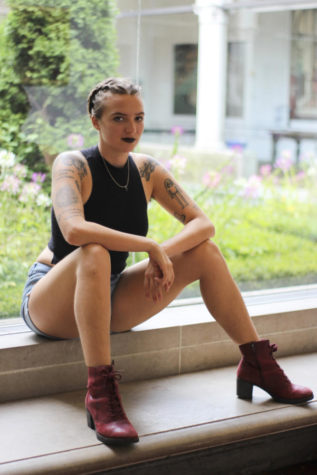Whether its crafting art or creating apps, Pitt students are finding ways to turn their passion projects into profit.
For some, the track to success took unexpected turns through cadaver labs and art studios, while for others it was a matter of making life a little easier.
Pitt seniors Brian Amaratunga and Akhil Aniff started their entrepreneurial journey with a scheduling conflict. They were unable to TA for a physics course, so Amaratunga suggested the duo start their own teaching assistant service similar to Uber — where students could request a TA from their phones whenever they needed to.
Both engineering majors, Amaratunga and Aniff were inspired by a required course they both took called The Art of Making. The class got Amaratunga into “the mindset of being an entrepreneur” and convinced him that he could set his business aspirations into motion while still in college.
The idea evolved into an app called Simi, a social network through which students could form study groups and review course material. They spent the summer working on Simi with Pitt’s Innovation Institute, launching a mobile app in October 2015.
“That version didn’t go anywhere, no one really used it,” Amaratunga said. “We spent the spring semester revising the product and figuring out what we could do better.”
The pair improved Simi by working with several start-up incubators — companies that provide mentorship in business training — including Blast Furnace, the Innovation Institute and Ascender — formally known as Thrill Mill. They won $15,000 in the Randall Big Idea Competition after their app pitch came in second place.
Aniff and Amaratunga said they still felt unsatisfied with their app, leading them to spend the summer of 2016 interviewing 30 different students, professors and tutors at Pitt in order to research study habits and needs for their app.
“We realized there was this need for students to improve their progress and track how they were doing,” Amaratunga said. “We coined this idea of a FitBit for your homework for college students.”
After spending $10,000 and more than two and a half years on the project, they’ve revised their original app into Ediyu — which allows users to track and manage their studying habits on a daily basis.
Aniff said entrepreneurship has its challenges. However, rather than allowing every challenge to be a failure and setback, it is also an opportunity to learn from past mistakes.
“When you fail, you learn, you grow,” Aniff said.
The two are planning to focus solely on product development until the end of senior year so that they have time to work on further developing, coding and talking to users.
“We’re sort of putting the business side of things on hold,” Amaratunga said.
Amaratunga and Aniff aren’t the only students who have developed their skills and made money — Olivia Fan, a senior neuroscience major and studio arts minor, gets paid to draw dead bodies.
When Fan shadowed an orthopedic surgeon two summers ago, the surgeon discovered her talent for medical illustrating after seeing sketches she drew of medical models. Impressed by Fan’s ability, he asked her to illustrate for his website, both for decorative purposes and to illustrate different procedures that his patients could receive.
By working in cadaver labs and shadowing the surgeon in the operating room, Fan honed her techniques as part of the internship and began to earn a little money — between $50 and $100 per drawing.
“It really helped when I was illustrating medical procedures, seeing what people could get,” Fan said. “I had to really look at super real models and dead people, obviously.”
Sarah Thornton, a recent Pitt graduate with a degree in studio arts, is also making money off her artwork — but her expertise is abstract color painting.
Thornton recently had their first solo gallery show at Artisan Gallery and Coffee Shop in Bloomfield. The show opened Sept. 1, with Thornton selling three paintings that night. Thornton feels confident in their artwork and appreciates that it is being recognized by the Pittsburgh community and on social media.
“When I have openings, I’ve had strangers come up to me, and be like, ‘oh I really like your work,’” Thornton said. “And I’m like, ‘I don’t know you, that’s crazy.’”

The pricing for Thornton’s work depends on size — their largest painting went for $300, and two smaller ones sold for around $50. Thornton has also sold some of their work through Instagram and Facebook.
Thornton had advice for artists who may be hesitant about putting out their artwork for fear of being cruelly judged by others.
“If you’re shy about sharing your work that means it is important to you,” Thornton said. “[But] art that sits in a closet is useless.”
Fan, who wants to work as an intraoperative neuromonitor — a person who monitors nerve damage during spinal, brain and lymph node surgeries — enjoys other art forms, but likes that medical illustrating gives her a purpose.
“It’s nice to see that people will look at my stuff, and there’s no way they can’t gain information from it,” Fan said. “They’ll learn something.”
Balancing money-making endeavors, class schedules and other extracurriculars is difficult for many students, but Fan feels the flexibility of her medical illustrating works for her.
“It’s really nice to work for myself and make my own hours, which I don’t think a lot of college kids get to do,” Fan said.



